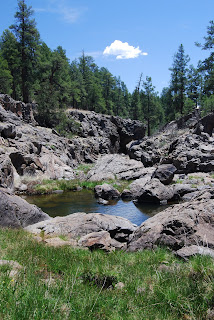


 SYCAMORE RIM
SYCAMORE RIMKaibab National Forest, Sycamore Canyon Wilderness
A meager crack in a wind-swept prairie marks the origin of Arizona’s second largest canyon. In fact, the source of Sycamore Canyon is so subdued that, without an understanding of the area’s geology, you’d probably stroll right past it without giving it second thought. From its humble birthplace on the prairie, the canyon cuts a meandering 20-mile-long gorge stretching from the Colorado Plateau to the Verde Valley. A hike along the Sycamore Rim trail samples the canyon’s diversity by tracing slumping earthen edges as they fall away into gaping crevasses, dry waterfalls, natural stone tanks brimming with water and spring-fed meadows drenched in wildflower color. Although it is first runner up in size when compared to the Grand Canyon, this many-fingered precipice is second to none in geological complexity and visual interest. Landscapes--both harsh and soft--serve up a delicious dichotomy of wonders. Moving seamlessly between lifeless, stone-cold canyons and sun-washed fields of lusty, waist-high grasses, this trail is saturated with ever-changing eye candy. Interpretive signs at key points along the route explain the significance of logging ruins, water sources, geology, old roads and the delicate eco-system of a bucolic spring area where water lilies bob in shallow pine-rimmed pools.
HIGHLIGHTS: Magnificent views, deep canyon, historic ruins, spring-fed meadows.
LENGTH: 11-mile loop
RATING: moderate
ELEVATION: 3,600’ – 6,500’
Driving Distance from Phoenix: 185 miles one-way
GETTING THERE: From Flagstaff, travel west on I-40 to the Garland Prairie (exit #167). Go south on Forest Road 141 for roughly 9 miles to the turnoff on the right for Forest Road 56. Follow FR-56 for 1.5 miles to the signed trailhead.
NOTE: there are five major trailheads for this hike. This one is the easiest to find. See the Kaibab National Forest website for maps.
Information: (928) 635-8200 or fs.fed.us/r3/kai


 HARQUAHALA PACK TRAIL Harquahala Mountain Wilderness Area An abandoned solar observatory on top of the 5,691-foot summit of Harquahala mountain, the highest point in southwestern Arizona, is but one of many points of interest atop this desert peak. Stunning views of the sprawling farmlands near Wickenburg, a healthy desert tortoise population, skulking Gila monsters and ruins of an abandoned mine camp provide hours of visual interest along the narrow pack trail that spirals skyward from the desert floor. Just below the summit, there’s a mountain pass with good views of a precipitous dirt road that snakes up the massive south slopes of the mountain. In addition to being a favorite destination for brave 4 x 4 enthusiasts, the bumpy route also is used by Central Arizona Project workers to access the array of solar-powered equipment on the apex which regulates the flow of water in the CAP canals that criss-cross the Metro Phoenix area. LENGTH: 11.5 miles round-trip RATING: difficult ELEVATION GAIN: 3,291 feet GETTING THERE: From Phoenix, take Highway 60 (Grand Avenue) west towards Wickenburg. From Wickenburg, continue on Highway 60 for about 14 miles past the little town of Aguila. Between mile markers 70 and 71, look for a gate on the left and a small brown “trail” sign and turn onto the dirt road. You’ll need to open the latched gate and close it behind you. Follow the generic “trail” signs for 2.2 miles to the trailhead where there’s an interpretive sign and a restroom. Information: Arizona Bureau of Land Management, http://www.blm.gov/az/st/en/prog/recreation/autotour/harq_summit.html
HARQUAHALA PACK TRAIL Harquahala Mountain Wilderness Area An abandoned solar observatory on top of the 5,691-foot summit of Harquahala mountain, the highest point in southwestern Arizona, is but one of many points of interest atop this desert peak. Stunning views of the sprawling farmlands near Wickenburg, a healthy desert tortoise population, skulking Gila monsters and ruins of an abandoned mine camp provide hours of visual interest along the narrow pack trail that spirals skyward from the desert floor. Just below the summit, there’s a mountain pass with good views of a precipitous dirt road that snakes up the massive south slopes of the mountain. In addition to being a favorite destination for brave 4 x 4 enthusiasts, the bumpy route also is used by Central Arizona Project workers to access the array of solar-powered equipment on the apex which regulates the flow of water in the CAP canals that criss-cross the Metro Phoenix area. LENGTH: 11.5 miles round-trip RATING: difficult ELEVATION GAIN: 3,291 feet GETTING THERE: From Phoenix, take Highway 60 (Grand Avenue) west towards Wickenburg. From Wickenburg, continue on Highway 60 for about 14 miles past the little town of Aguila. Between mile markers 70 and 71, look for a gate on the left and a small brown “trail” sign and turn onto the dirt road. You’ll need to open the latched gate and close it behind you. Follow the generic “trail” signs for 2.2 miles to the trailhead where there’s an interpretive sign and a restroom. Information: Arizona Bureau of Land Management, http://www.blm.gov/az/st/en/prog/recreation/autotour/harq_summit.html


























